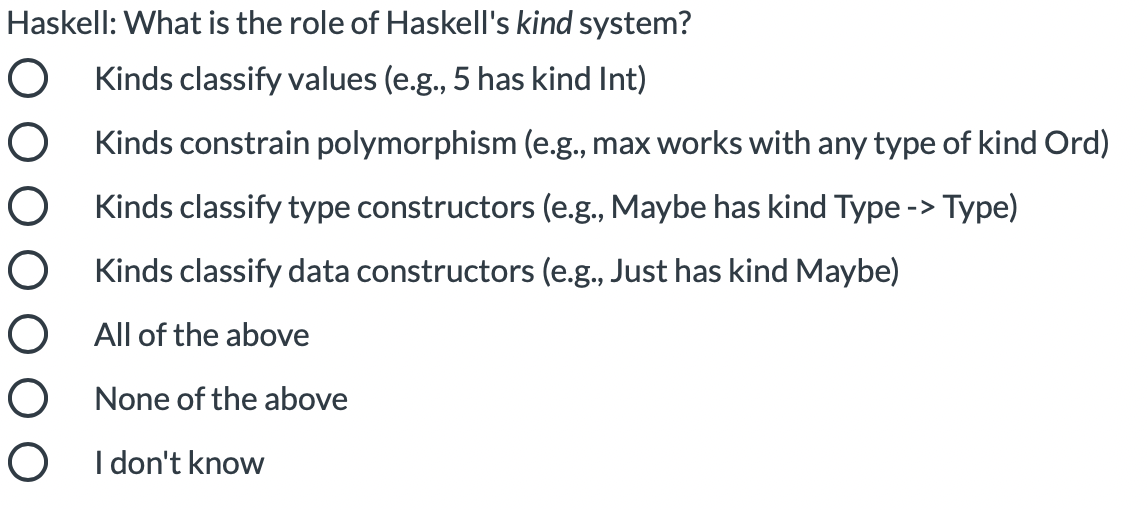Haskell: What is the role of Haskell's kind system? O Kinds classify values (e.g., 5 has kind Int) O Kinds constrain polymorphism (e.g., max works with any type of kind Ord) O Kinds classify type constructors (e.g., Maybe has kind Type -> Type) O Kinds classify data constructors (e.g., Just has kind Maybe) O All of the above O None of the above O I don't know
Haskell: What is the role of Haskell's kind system? O Kinds classify values (e.g., 5 has kind Int) O Kinds constrain polymorphism (e.g., max works with any type of kind Ord) O Kinds classify type constructors (e.g., Maybe has kind Type -> Type) O Kinds classify data constructors (e.g., Just has kind Maybe) O All of the above O None of the above O I don't know
Database System Concepts
7th Edition
ISBN:9780078022159
Author:Abraham Silberschatz Professor, Henry F. Korth, S. Sudarshan
Publisher:Abraham Silberschatz Professor, Henry F. Korth, S. Sudarshan
Chapter1: Introduction
Section: Chapter Questions
Problem 1PE
Related questions
Question

Transcribed Image Text:Haskell: What is the role of Haskell's kind system?
O Kinds classify values (e.g., 5 has kind Int)
Kinds constrain polymorphism (e.g., max works with any type of kind Ord)
Kinds classify type constructors (e.g., Maybe has kind Type -> Type)
Kinds classify data constructors (e.g., Just has kind Maybe)
All of the above
O None of the above
O I don't know
![Haskell: Recall the function (++), as defined in the Prelude
[ ]
(х:xs) ++ ys 3D х :
++ ys
ys
(xs ++ ys)
If we have four large lists we wish to concatenate, which of the expressions below is the most efficient?
a ++ (b ++ (c ++ d))
O (a ++ b) ++ (c ++ d)
a ++ (b ++ c) ++ d
O ((a ++ b) ++ c) ++ d
O All of the above
O None of the above
O I don't know](/v2/_next/image?url=https%3A%2F%2Fcontent.bartleby.com%2Fqna-images%2Fquestion%2F2ae8a81d-a7d2-4710-8da9-0de0f94786a9%2F9df7a493-d7ab-4f33-8e8e-a4e7e27ebc4e%2Fhttsvrn_processed.png&w=3840&q=75)
Transcribed Image Text:Haskell: Recall the function (++), as defined in the Prelude
[ ]
(х:xs) ++ ys 3D х :
++ ys
ys
(xs ++ ys)
If we have four large lists we wish to concatenate, which of the expressions below is the most efficient?
a ++ (b ++ (c ++ d))
O (a ++ b) ++ (c ++ d)
a ++ (b ++ c) ++ d
O ((a ++ b) ++ c) ++ d
O All of the above
O None of the above
O I don't know
Expert Solution
This question has been solved!
Explore an expertly crafted, step-by-step solution for a thorough understanding of key concepts.
Step by step
Solved in 2 steps

Knowledge Booster
Learn more about
Need a deep-dive on the concept behind this application? Look no further. Learn more about this topic, computer-science and related others by exploring similar questions and additional content below.Recommended textbooks for you

Database System Concepts
Computer Science
ISBN:
9780078022159
Author:
Abraham Silberschatz Professor, Henry F. Korth, S. Sudarshan
Publisher:
McGraw-Hill Education

Starting Out with Python (4th Edition)
Computer Science
ISBN:
9780134444321
Author:
Tony Gaddis
Publisher:
PEARSON

Digital Fundamentals (11th Edition)
Computer Science
ISBN:
9780132737968
Author:
Thomas L. Floyd
Publisher:
PEARSON

Database System Concepts
Computer Science
ISBN:
9780078022159
Author:
Abraham Silberschatz Professor, Henry F. Korth, S. Sudarshan
Publisher:
McGraw-Hill Education

Starting Out with Python (4th Edition)
Computer Science
ISBN:
9780134444321
Author:
Tony Gaddis
Publisher:
PEARSON

Digital Fundamentals (11th Edition)
Computer Science
ISBN:
9780132737968
Author:
Thomas L. Floyd
Publisher:
PEARSON

C How to Program (8th Edition)
Computer Science
ISBN:
9780133976892
Author:
Paul J. Deitel, Harvey Deitel
Publisher:
PEARSON

Database Systems: Design, Implementation, & Manag…
Computer Science
ISBN:
9781337627900
Author:
Carlos Coronel, Steven Morris
Publisher:
Cengage Learning

Programmable Logic Controllers
Computer Science
ISBN:
9780073373843
Author:
Frank D. Petruzella
Publisher:
McGraw-Hill Education